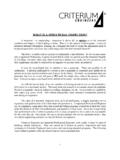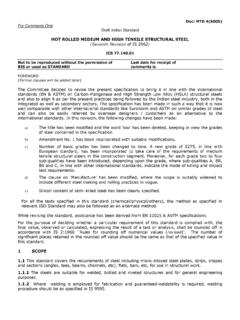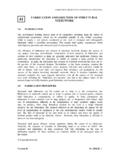Transcription of D D2.1 Database on Defects - Stacast project
1 Stacast - New Quality and Design Standards for Aluminium Alloys Cast Products FP7-NMP-2012-CSA-6 - project N. 319188 Stacast : New Quality and Design Standards for Aluminium Alloys Cast Products Deliverable : Database on Defetcs Authors: F. Bonollo, G. Timelli, E. Fiorese, E. Gariboldi, P. Parona, L. Arnberg 1 COORDINATION AND SUPPORT ACTION (SUPPORTING) Call: FP7-NMP-2012-CSA-6 Support for standardisation needs project full title: New Quality and Design Sta ndards for Aluminium Alloys Cast Products project acronym: Stacast Co-ordinator name Franco BONOLLO Co-ordinator organisation name University of Padova DTG Co-ordinator email and fax +39 0444 998889 Co-ordinator phone + 39 0444 998743 DELIVERABLE Database on Defects AUTHORS: F. BONOLLO, G. TIMELLI, E. FIORESE (UNIVERSITY OF PADOVA DTG) E. GARIBOLDI, P. PARONA (ITALIAN ASSOCIATION OF METALLURGY AIM) L. ARNBERG (UNIVERSITY OF TRONDHEIM NTNU) Date: March 29th, 2013 Stacast - New Quality and Design Standards for Aluminium Alloys Cast Products FP7-NMP-2012-CSA-6 - project N.
2 319188 Stacast : New Quality and Design Standards for Aluminium Alloys Cast Products Deliverable : Database on Defetcs Authors: F. Bonollo, G. Timelli, E. Fiorese, E. Gariboldi, P. Parona, L. Arnberg 2 Database on Defects 1. Introduction Defects are intrinsically generated by casting processes, due to several reasons. The final properties and in-service behaviour of castings are always related to microstructural features and to Defects : both microstructure and Defects are the results of process stages, alloys properties and dies & tools design. As an example, it should be considered that in HPDC filling stage extreme conditions are established: complexity of components leads to complex dies, and the high production rates required (up to 120 shots/h) lead to very high filling velocities for the molten alloy (up to 40 m/s) with strong generation of turbulence in the flow.
3 Solidification takes place in few seconds, and the die is first in contact with a molten alloy at more than 700 C and, after 30-40 seconds, with a sprayed lubricant at room temperature. For these reasons HPDC (as well as other Aluminium alloys casting processes, such as permanent mold casting process) can be considered a defect generating process . Not only an average 5-10% scrap is typically produced, but the type, size and severity of Defects are varying. From these considerations, it seems that the potential of high-pressure die-casting and permanent mold casting processes will be completely exploited only when the quality level will be perfectly optimised. In this regard, the analysis of Defects allows the foundry to monitor the products quality respect to a quality standard. Further, the analysis of Defects provide to the foundry useful correlations between Defects type/distribution and their origin, so that it could be possible to define process modification for improving the quality.
4 One of the current targets of the Stacast project is the compilation and dissemination of common tools to allow foundries to define a proper, comparable, quality standard. The first tool to be proposed is a common basis of language, a terminology and classification of Defects in order to help die-casting foundries to face with increased confidence and ability the defect-related issues, to assure quality and reliability of their products. 2. The path towards a new Standard on Defect Classification Previous classifications of Defects There are three main approaches for Defects classification of cast components proposed in literature or currently adopted by foundries: - Cocks approach based on Defects geometry/location - Campbell approach based on Defects metallurgical origin/causes - NADCA approach based on Defects morphology. The first approach was proposed by Cocks and discerns between surface and internal Defects (Table 1).
5 The surface Defects are visible by naked eye and impact both on the product aesthetics and functionality. On the other hand, the internal Defects influence only the in-service properties of the component. As shown in Table 2, the second approach, proposed by Campbell, classifies Defects on the basis of their metallurgical origin/causes (casting geometry, cast alloy, die characteristics, die lubrication, process parameters, etc.). The main advantage offered by this classification is the opportunity to design and adopt strategies to improve products quality. The main disadvantage of this approach is that the origin/causes of the defect must be defined concurrently to defect identification and that a single defect can be due to several concurring factors. Further, this approach is less suitable for Stacast - New Quality and Design Standards for Aluminium Alloys Cast Products FP7-NMP-2012-CSA-6 - project N.
6 319188 Stacast : New Quality and Design Standards for Aluminium Alloys Cast Products Deliverable : Database on Defetcs Authors: F. Bonollo, G. Timelli, E. Fiorese, E. Gariboldi, P. Parona, L. Arnberg 3 direct application in foundries with respect to geometry/position-based approaches, where specific inspections can be proposed to reveal different defect groups. The third approach was proposed by NADCA (North America Die Casting Association) and is based on Defects morphology. NADCA suggested seven Defects categories, that are indicated by a letter (Table 3). Each category is divided into groups, that are divided into subgroups. Category Class Type 1-General 2-Splash and shotting 3-Vortex 1-Cold shut 4-Lamination 1-Blisters 2-Sinks 2-Smooth irregularities 3-Lakes 1-Drag marks 1-Surface Defects 3-Rough surface 2-Solder 1-Hydrogen 1-Gas porosity 2-Oxidizing gases 1-Gross 2-Intergranular Cocks classification 2-Internal Defects 2-Shrink porosity 3-Cracks - hot tears Table 1.
7 Classification of casting Defects according to Cocks. Gas in solution (hydrogen) Gas entrapment during filling (air) Gas porosity Binder breakdown (core gases) Macro-porosity Shrinkage porosity Micro-porosity (interdendritic) Campbell classification Hot tearing, cracks Table 2. Classification of casting Defects according to Campbell. Category A-Metallic projection B-Cavities C-Discontinuities D-Defective surface E-Incomplete casting F-Incorrect dimension or shape NADCA classification G-Inclusion or structural anomalies Table 3. Classification of casting Defects according to NADCA. Stacast - New Quality and Design Standards for Aluminium Alloys Cast Products FP7-NMP-2012-CSA-6 - project N. 319188 Stacast : New Quality and Design Standards for Aluminium Alloys Cast Products Deliverable : Database on Defetcs Authors: F. Bonollo, G. Timelli, E. Fiorese, E. Gariboldi, P. Parona, L. Arnberg 4 Proposal of new classification of Defects Recently, the AIM (Italian Association of Metallurgy), after a 2-years survey carried out involving about 50 Al-alloys foundries, suggested a new classification approach, based on a 3-levels Defects individuation: I) morphology/location of Defects (internal, external, geometrical); II) metallurgical origin of Defects ( gaseous porosity, solidification shrinkage, etc.
8 ; III) specific type of Defects (the same metallurgical phenomenon may generate various Defects ). The level I is based on morphology/location of Defects , with reference to the investigation techniques suitable for their detection (visual inspections and controls involving the bulk material): there are internal and external (or surface) Defects . Sub-surface Defects ( so close to the surface that they can affect external aspect detectable by conventional surface investigation techniques), are considered surface Defects . Finally, the geometrical Defects refer to the casting shape in terms of dimensions and tolerances. The level II is mainly focussed on the metallurgical origin of Defects . Defects are grouped into several classes according to their general metallurgical origin: - Defects related to the presence of gas (gas-related Defects ); - Defects related to material volume contraction during metal solidification (shrinkage Defects ); - Defects related to thermal contraction prevented by previously solidified metal or by the die (thermal contraction Defects ); - Defects related to incorrect filling of the die-cavity (filling Defects ); - Defects related to metal/mould interaction; - Defects related to the presence of unsuitable phases (undesired phases), originated by the interaction of the metal with external environment during melting, casting, filling or extraction/ejection from the mould.
9 As previously observed, the knowledge of metallurgical origin could supply starting points for corrective actions (including process parameters). The level III is used to identify the specific types of Defects . Usually, the term adopted to describe a particular type of defect allows a better definition of the metallurgical origin of the defect itself, which was preliminarily identified in the previous level. Such approach has been widely described in a report published [E. Gariboldi, F. Bonollo, P. Parona, Handbook of Defects in HPDC, AIM, Milano], and certainly constitutes the basis for the first relevant Stacast Objective, the definition of a New Standard on Defects classification. The present classification of Defects is of hybrid type and multi-level, as schematically shown in Tables 4, 5 and 6. The proposal refers to metallurgically-based Defects of HPDC and permanent mold casting products.
10 Defects directly related to handling, finishing, machining operations following ejection from the die are excluded from the classification, even if they could be possible causes for product rejection. In this way, the range of defect types is not excessively wide. Stacast - New Quality and Design Standards for Aluminium Alloys Cast Products FP7-NMP-2012-CSA-6 - project N. 319188 Stacast : New Quality and Design Standards for Aluminium Alloys Cast Products Deliverable : Database on Defetcs Authors: F. Bonollo, G. Timelli, E. Fiorese, E. Gariboldi, P. Parona, L. Arnberg 5 1st Level 2nd Level 3rd Level Macro-shrinkage Interdendritic shrinkage A1 Shrinkage Defects Layer porosity Air entrapment porosity Hydrogen porosity Vapour entrapment porosity A2 Gas-related Defects Lubricant entrapment porosity Joint Lamination A3 Filling-related Defects Cold shot Inclusion A4 Undesired phases Undesired structure Crack A Internal Defects A5 Thermal contraction Defects Hot tear Table 4.






